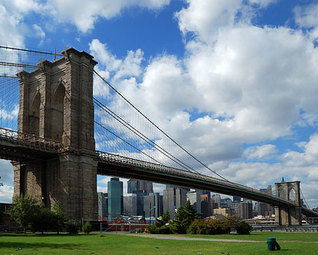Brooklyn Bridge Park - Brooklyn, NY
Brooklyn Bridge Park is a prime example of transforming antiquated and under-used land into a healthy and popular public space attraction. The park, which is still being fully implemented, sits on the site of Brooklyn's once highly industrial waterfront, which featured a thriving port. However, as time progressed, the importance of the site decreased. As a result, the physical stock of both the land and infrastructure began to deteriorate. Recent efforts, though, have reclaimed this crucial parcel of land for public enjoyment and use. The park, which is located on the East River waterfront directly adjacent to and facing the skyline of Lower Manhattan, has rapidly become a popular spot in the borough. It has also aided incredibly in the re-emergence and redevelopment of neighborhoods within close proximity.
The face of Brooklyn has undergone quite a transformation near the turn of the twenty-first century and beyond. It has quickly became an artistic and cultural gathering place as well as incubator for all types of innovative ideas. Among the most prevalent of these innovations throughout the borough is through its redevelopment practices. The park itself is a thorough example of this, as it incorporates several existing historic structures into its design and infrastructure. It spans 85 acres along the East River shoreline near downtown Brooklyn, and its territory marches under both the Brooklyn and Manhattan Bridges. The park also includes six piers and existing warehouses, as well as the Historic Fulton Ferry Landing. These are all remnants of an era where the Brooklyn riverfront played a vital role in the economic growth and dominance of New York City, especially during the era when Brooklyn was a separate municipality. It was a vital transportation and shipping node for not only the city, but the entire region. However, the site's fortunes changed with construction of the bridges to Manhattan, as well as the dominance of rail and, later, automobile transportation.
The face of Brooklyn has undergone quite a transformation near the turn of the twenty-first century and beyond. It has quickly became an artistic and cultural gathering place as well as incubator for all types of innovative ideas. Among the most prevalent of these innovations throughout the borough is through its redevelopment practices. The park itself is a thorough example of this, as it incorporates several existing historic structures into its design and infrastructure. It spans 85 acres along the East River shoreline near downtown Brooklyn, and its territory marches under both the Brooklyn and Manhattan Bridges. The park also includes six piers and existing warehouses, as well as the Historic Fulton Ferry Landing. These are all remnants of an era where the Brooklyn riverfront played a vital role in the economic growth and dominance of New York City, especially during the era when Brooklyn was a separate municipality. It was a vital transportation and shipping node for not only the city, but the entire region. However, the site's fortunes changed with construction of the bridges to Manhattan, as well as the dominance of rail and, later, automobile transportation.
|
By the 1950s, the already deteriorating waterfront was dealt another setback as the Brooklyn Queens Expressway severed connections to Brooklyn Heights, a neighborhood directly to the east of it. By the 1980s, the Port Authority had stopped shipping operations at the port. Therefore, a double impact of decreased access and foot traffic combined with limited industry and business severely altered the site in a downward trajectory. It was during this time that concerned waterfront advocates began pushing for a redevelopment of the area, promoting it as a positive spot for public space. That same group grew into the Brooklyn Bridge Park Conservancy, which is currently charged with operating the park. In the late 1990s, a master plan for the park's development was created after an intensive public outreach process. By 2002, the city and state agreed to develop and operate the park in accordance with the guidelines put forth in the master plan. As a part of the agreement, there is a mandate that all park maintenance and operations are required to be economically self-sufficient, with funding coming from revenues from site commercial and residential development.
|
The park, which as of 2013 is not fully completed, features numerous paths, walkways, and attractions on a site that was once almost purely industrial. It is divided into eleven relatively unique but continuous sections, each with its own attractions, views, and topography. Concessions, unique developments, and environmental restoration projects dot the park's landscape. Numerous sports fields and facilities also play a prominent role in the park, and they serve a vital role in the dense city environment in which it is located. Brooklyn Bridge Park is a visionary project of reclaiming and improving land with the public interest in mind. It is truly a park for the 21st century and, although not fully completed, is an example for other deteriorated waterfronts to follow, even if all cannot lay claim to a prized view of Manhattan.



